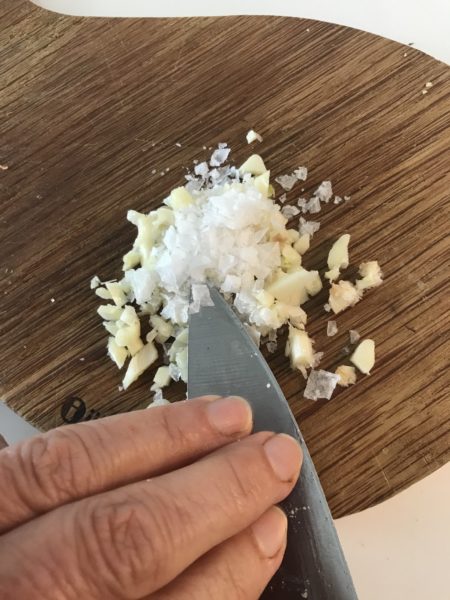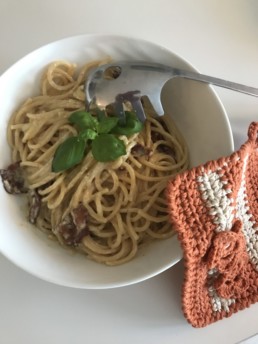What’s for Supper – pasta with roasted tomato sauce or how to purée garlic and the transforming powers of salt
There are dishes that I cook over and over, and have done since I first started cooking a very long time ago. They are all simple, and their addictive deliciousness comes from doing very little to good ingredients.
Out of those, some are so much a part of my routine that I cook them weekly. Roast chicken (not least for that best of leftovers, cold chicken) a soup made from seasonal vegetables and pasta with some sort of plant based accompaniment. I love the southern Italian pasta dishes in particular. The dishes from this parched tip of the country are totally different from those of the north, where rich pasture land have given birth to meat and dairy rich dishes such as the classic sauce from Bologna. In the south, the holy trinity of tomatoes, garlic and chilli are put to good use.
Since I started cooking while at Uni, doing a History of Art degree, I have cooked pasta with tomato sauce, in some shape or form. The flavours I crave when I make it have remained the same: sweet, hot and umami – almost Asian in profile, as acidity also underpins it.
In my opinion, Tomatoes must never be deprived of the company of their best friend in the kitchen; sugar.
Unless picked ripe from a sun drenched branch, tomatoes are very high in acidity and the difference a teaspoon of caster sugar, or a lug of Balsamic vinegar makes to any sauce in which tomatoes play a part is huge. My latest discovery, borrowed from a completely different cuisine, is that Pomegranate molasses also work exceptionally well with tomatoes.
When we teach in the school, guests are often surprised at how gadget free our state of the art kitchen is. Apart from our Neff hobs and ovens, our Kenwood blenders and our knives, we don’t use gadgets. One of the first thing our attendees scan the table for are garlic presses. We don’t have them as garlic puréed with sea salt is infinitely better in every way.
Salt, added to a raw animal protein, whether a plant or from an animal, will draw out liquid from the protein. This is why you should avoid adding salt to a nice piece of steak, chicken or fish until just before it goes in the oven or pan. If you leave salt to sit on the protein you are planning to cook, it will result in a wet surface, which means when you come to cook it it, it won’t brown or caramelise, it will simply stew and result in a grey, unappetising look with inferior flavour. The caramelising you achieve by browning is essential for flavour. Contrary to popular belief, browning does not seal in juices. Only resting does that.
My rule of thumb is rest meat for at least as long as it cooked for. A rack of lamb cooked for 16-17 minutes should rest for 16-17 minutes. The exceptions to the rule are obvious; a steak, cooked rare for only a couple of minutes, benefits from resting for longer than that and a large leg of lamb or a chicken obviously does not require resting for up to an hour, but 15-20 minutes will ensure that the juices are retained in the meat so that when it is carved, they juices won’t simply go to waste on your carving board.
Capitalising on the liquid-drawing powers of salt when preparing garlic stops it from burning and also results in superior flavour. All cooks will have added raw garlic to a pan of hot fat and seen in go from creamy white to little bits of burnt charcoal in seconds. Burning garlic results in little bitter tasting, crisp pieces of charcoal scattered through the dish it underpins. This is where salt comes in.
Start by placing the flat side of a large chef’s knife on a garlic clove and give it a good bash with your fist to split the skin, then peel. Next, roughly chop the garlic and add about a third of its volume in sea salt. Now, place a couple of fingers on the flat side of the tip and use it as if it were the beak of a little bird, pecking into the salt and garlic. Keep pecking away – some bits of garlic will go flying – and you will immediately see how the salt teases out water from the garlic. Continue working the tip of the knife though the garlic for about a minute. When the salt has melted and the bits of garlic have started to disintegrate, stop pecking and move your fingers further down the flat blade of the knife, so that the flat of your fingers are pressing down on the knife and paddle across the board, smearing the garlic back and forth. Within seconds it will transform into a paste.
This wet garlic paste will not burn. Instead it will blend and integrate well with the other ingredients and the flavour will be more subtle, almost almond-like.
This is how:




Now for my long standing favourite version of tomato sauce.
The ingredients are simple: fresh cherry tomatoes, of which there seems to be a constant abundance, garlic, sea salt, chilli flakes, tomato purée, caster sugar and fresh basil. If you happen to have a bottle of Pomegranate molasses in your cupboards, add a splash of that too or add a little splash of Balsamic vinegar towards the end of cooking.
And of course, we want grated Parmesan. If you don’t have Parmesan, any mature hard cheese will do just as fine. A strong Cheddar, or even better, one of my two all time favourite Alpine cheeses, Gruyère or Comté will taste fantastic. Dare I say it, even more delicious in this context than Parmesan.
I like chucking roughly 1/3 of the tomatoes in the oven with a bit if salt and sugar and a drizzle of olive oil and roast them at 180C ish while I cook down the remaining 2/3 in a pan with puréed garlic, a good squirt of tomato purée, caster sugar and a sprig of basil. I start with the garlic and tomato, and as soon as they start to break down, say 3 minutes of cooking, I add the rest and a good splash of water or red wine, or a mix of both. Stir and simmer for 5-10 minutes. No need to add salt – there is plenty in the garlic.


Let the tomatoes in the pan simmer down and break up, giving them a helping stir with a wooden spoon every now and then and adding a little water if the sauce is cooking down very thick. The tomato purée will thicken the sauce quite a lot.
Cooking down the tomatoes – a little film clip here
Tip the oven roasted tomatoes, with their cooking juiced, into the pan. Check the seasoning, adding more sugar if there is not sufficient underlying sweetness in the tomatoes yet.

Meanwhile you will have cooked your pasta al dente.
How to cook perfect pasta
You need a really large saucepan, and 1 small tablespoon of salt per litre. That’s right – 1 tablespoon of salt per litre. Nothing else – no oil. It is the volume of water which ensures that pasta strands don’t stick. Cook your chosen pasta for a couple of minutes less than suggested on the pack. The salt and shorter cooking time will ensure al dente pasta – that is to say pasta that is cooked, yet retains a little bite at the core, easing the effect of this rich dish on your gut and on your blood sugar levels. For Bucatini this means about 8-9 minutes. When cooked, lift the pasta using a pasta fork – don’t drain into a colander. This removes the need for dangerous lifting and moving of large pans full of hot water and also eliminates the risk of burns to hands and lower arms. The purpose for the cook, however, is to transfer pasta straight out of the water and into the waiting sauce. If you have never tried this you’ll be amazed at the difference it makes to any pasta dish, compared to topping quickly drying pasta with a sauce.
My choice of pasta is, as always, Bucatini – long hollow pasta tubes. They have more texture and bite to them than other thin pasta and the hollow centre interacts very pleasingly with the sauce when being devoured.

Bring the salted water to a rolling boil. This is what a rolling boil looks like. Don’t put a lid on and keep an eye on the pan. Give the pasta a stir when it first goes in.

The pasta has been added to the sauce, not the other way around.

Buon apetito!
What’s for Supper tomorrow
Some of you have asked for my recipe for cinnamon buns, the Swedish Kanelbullar.
What’s for Supper – Classic Carbonara
March 31, 2020



